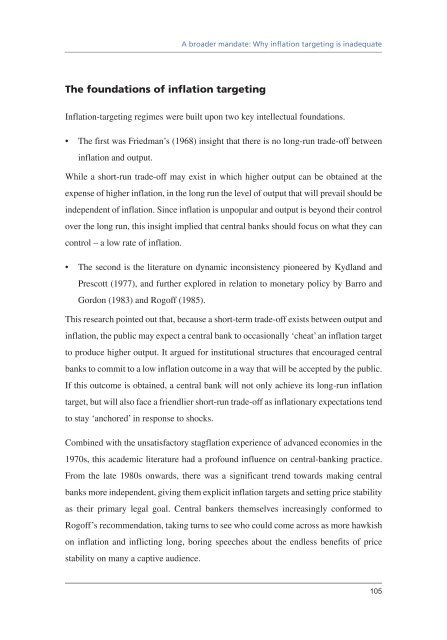You also want an ePaper? Increase the reach of your titles
YUMPU automatically turns print PDFs into web optimized ePapers that Google loves.
A broader mandate: Why <strong>inflation</strong> <strong>targeting</strong> is inadequateThe foundations of <strong>inflation</strong> <strong>targeting</strong>Inflation-<strong>targeting</strong> regimes were built upon two key intellectual foundations.• The first was Friedman’s (1968) insight that there is no long-run trade-off between<strong>inflation</strong> and output.While a short-run trade-off may exist in which higher output can be obtained at theexpense of higher <strong>inflation</strong>, in the long run the level of output that will prevail should beindependent of <strong>inflation</strong>. Since <strong>inflation</strong> is unpopular and output is beyond their controlover the long run, this insight implied that central banks should focus on what they cancontrol – a low rate of <strong>inflation</strong>.• The second is the literature on dynamic inconsistency pioneered by Kydland andPrescott (1977), and further explored in relation to monetary policy by Barro andGordon (1983) and Rogoff (1985).This research pointed out that, because a short-term trade-off exists between output and<strong>inflation</strong>, the public may expect a central bank to occasionally ‘cheat’ an <strong>inflation</strong> targetto produce higher output. It argued for institutional structures that encouraged centralbanks to commit to a low <strong>inflation</strong> outcome in a way that will be accepted by the public.If this outcome is obtained, a central bank will not only achieve its long-run <strong>inflation</strong>target, but will also face a friendlier short-run trade-off as <strong>inflation</strong>ary expectations tendto stay ‘anchored’ in response to shocks.Combined with the unsatisfactory stagflation experience of advanced economies in the1970s, this academic literature had a profound influence on central-banking practice.From the late 1980s onwards, there was a significant trend towards making centralbanks more independent, giving them explicit <strong>inflation</strong> targets and setting price stabilityas their primary legal goal. Central bankers themselves increasingly conformed toRogoff’s recommendation, taking turns to see who could come across as more hawkishon <strong>inflation</strong> and inflicting long, boring speeches about the endless benefits of pricestability on many a captive audience.105



